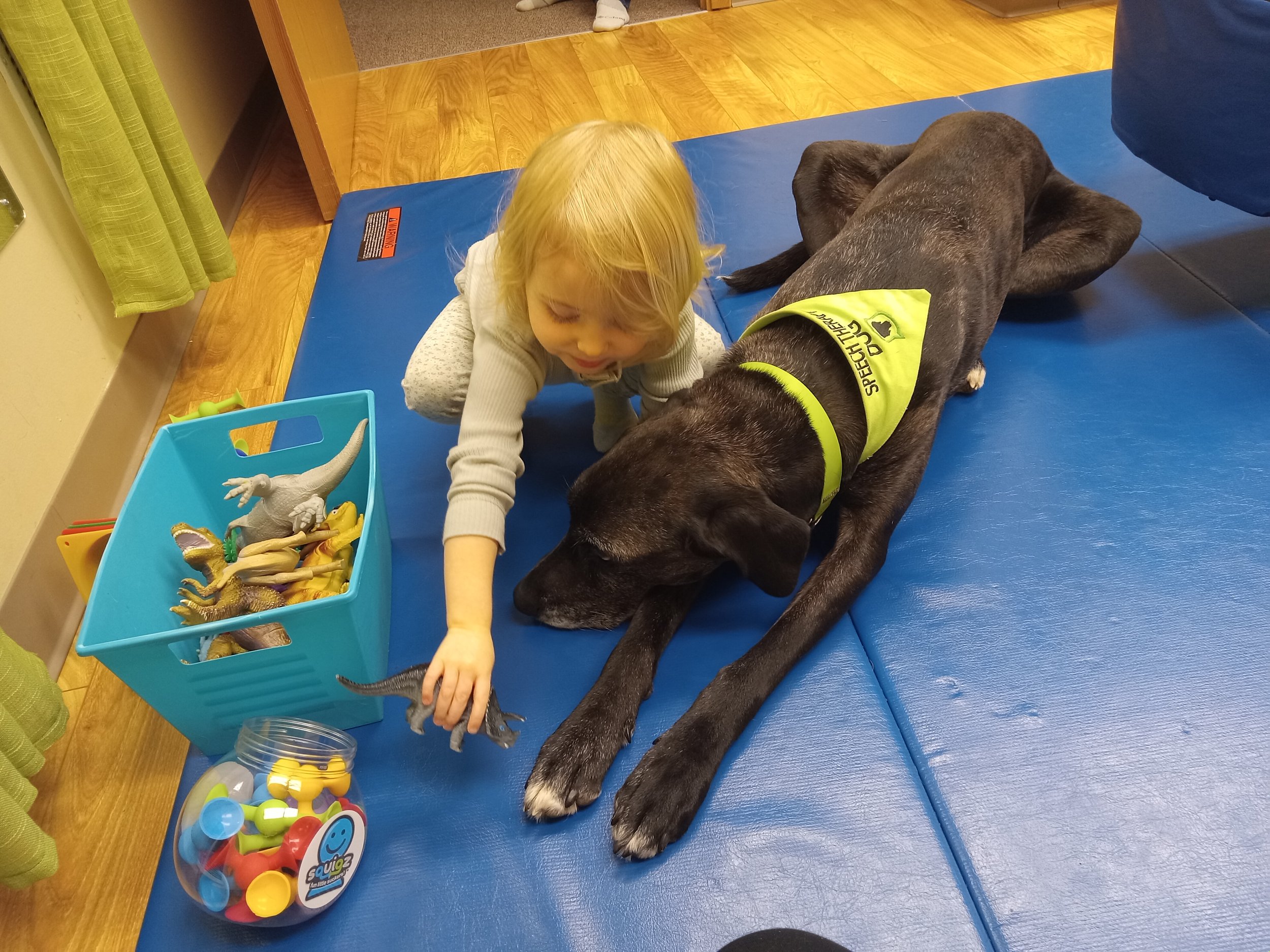5 Myths about Therapy Dogs: A Guide for Speech-Language Pathologists
If you google “therapy dog”, you’ll find images of serene-looking Golden Retrievers and Labradors, usually resting quietly alongside a person who is elderly or disabled.
Human interest stories aimed at the public often celebrate a therapy dog that is trained to perform lots of tricks to entertain or assist.
If your canine partner doesn’t fit this mold, you may think it’s impossible to use him or her in a professional role, but did you know that the core feature of a therapy dog is actually the ability to form a powerful human-animal bond? And that can look many different ways!
Let’s explore a few common misconceptions about speech therapy dogs as you decide if animal-assisted speech therapy is right for your practice:
Speech therapy dog Delta, a Labrador/Great Dane mix, watches a child play an articulation card game.
#1 Therapy dogs are only for motor therapists and mental health professionals.
False! Because of a therapy dog’s ability to ease anxiety and motivate, they can be great tool to improve human functioning in any area, including speech therapy, education, and even medical healing.
Although most resources on the subject to date have been written by and for mental health professionals, occupational therapists, and physical therapists, with creativity that basic information can be applied to speech therapy too!
(For details, check out Paws for Progress: Integrating Animal-Assisted Interventions into Your Speech-Language Pathology Practice from ASHA Press and Talk to the Paw: Therapy Animal Inclusion in a Professional Setting, a 7+ hour online course for all health and human service providers.)
#2 To be therapeutic, a speech therapy dog must be able to perform a lot of tricks.
False! In my practice, I have found the therapy dog’s presence alone to be enough to elicit more spontaneous utterances, provide motivation to practice a target sound or syntax form, and to help more anxious, reserved, or resistant clients self-regulate to complete therapy tasks.
A few basic tricks can be helpful to target specific goals (e.g., asking the dog to “spin” to practice s-clusters), but my dogs actually spend the majority of a session resting nearby.
Being able to treat or walk a dog can be rewarding for both the speech therapy client and the speech therapy dog, no special performance skills required.
For a clip of a therapy dog assisting in a speech session by resting nearby, click here.
Speech therapy dog Delta supports a toddler developing first words in animal-assisted speech therapy.
#3 A speech therapy dog can solve any problem.
False! While the therapy dog’s presence, whether actively engaging or simply being present, can be incredibly helpful with clients that are drawn to animals, the Speech-Language Pathologist must still use his or her clinical skills to choose meaningful goals, plan and adapt therapeutic activities, provide prompting, and monitor progress in order to elicit change.
It’s not about just playing with a cute pup, but addressing communication skills just as you would with books, games, and other therapy materials.
Furthermore, not all clients will take to a therapy dog enthusiastically and some may be motivated by the dog’s presence on some days but not others.
#4 A speech therapy dog must be calm all the time.
False! Although therapy dogs must behave safely, a more energetic personality can help stimulate a more passive or hyposensitive client, improve memorability of the therapy activity, and/or create unique and unplanned opportunities for communication (e.g., “Oh no, Bodhi jumped in the ball pit!”).
In my animal-assisted speech therapy practice, some kids prefer my Labradane’s calmer, slower-moving energy, others my ever-wiggling Brittany’s high energy, and some my unpredictable and goofy Catahoula pup’s antics, but I’ve been able to successfully incorporate all three to improve outcomes in different ways.
#5 All speech therapy dogs are “Goldens” or “Doodles”.
False! While Golden Retrievers, Labradors, and Poodles/Poodle mixes often have calm and personable temperaments that allow them to excel in this work, individuals from any breed or combination of breeds can potentially have the drive for closeness that makes a therapy dog truly beneficial.
Because dogs are bred for different jobs, some breeds tend to be easier to train and more likely to bond with a variety of humans, but each individual within a breed is unique.
While researching the book I found therapists partnering with Bulldogs, Huskies, Pitbulls, Chihuahuas, Great Danes, Corgis, Border Collies, Bernese mountain dogs, and a wide variety of mixes. An affiliative nature—the desire to interact with people—is the key trait when considering an individual for therapy dog work.
For more information about partnering with speech therapy dogs, follow our story on Instagram @Speech_Dogs and don’t forget to grab your FREE Roadmap to Partnering with a Speech Therapy Dog. And check out the videos on the Speech Dogs YouTube Channel!
I’d love to hear what your questions and concerns are regarding adding a therapy dog into your practice for future topics—contact me!
May your days be filled with puppy wiggles and children’s giggles,
Sharlet
.



